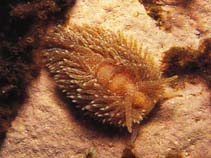Aeolidia papillosa (Linnaeus, 1761)
Shag-rug aeolisWarning: DOMDocument::load(): SSL operation failed with code 1. OpenSSL Error messages: error:140770FC:SSL routines:SSL23_GET_SERVER_HELLO:unknown protocol in C:\Apache24\htdocs\includes\SpeciesSummary.lib.php on line 1236
Warning: DOMDocument::load(): Failed to enable crypto in C:\Apache24\htdocs\includes\SpeciesSummary.lib.php on line 1236
Warning: DOMDocument::load(https://sealifebase.nrm.se/webservice/AquaMaps/getAMap.php?genus=Aeolidia&species=papillosa): failed to open stream: operation failed in C:\Apache24\htdocs\includes\SpeciesSummary.lib.php on line 1236
Warning: DOMDocument::load(): I/O warning : failed to load external entity "https://sealifebase.nrm.se/webservice/AquaMaps/getAMap.php?genus=Aeolidia&species=papillosa" in C:\Apache24\htdocs\includes\SpeciesSummary.lib.php on line 1236
Classification / Names Common names | Synonyms | CoL | ITIS | WoRMS
| Nudibranchia | Aeolidiidae
Environment: milieu / climate zone / depth range / distribution range Ecologie
; diepteverspreiding 0 - 380 m (Ref. 83435). Temperate; 85°N - 57°S, 180°W - 43°E
Verspreiding Landen | FAO regio's | Ecosystems | Voorkomen | Introducties
Arctic, Atlantic, Eastern Pacific and the Mediterranean Sea. Subtropical to polar.
Length at first maturity / Size / Gewicht / Leeftijd
Maturity: Lm ? range ? - ? cm Max length : 10.0 cm TL mannelijk/geslacht niet bekend; (Ref. 7726)
Assumed maximum length from Ref. 822. Known from intertidal to deep waters, in large aggregations of thirty or more individual adults (Ref. 7726). Free-living (Ref. 3123). Generally for group, planktonic and minute detrital food items through either suspension or deposit feeding (Ref. 87872). Feeds on various sea anemones (Ref. 822), particularly frilled anemone (Ref. 7726).
Life cycle and mating behavior Geslachtsrijpheid | Voortplanting | Kuitschieten | Eieren | Fecundity | Larven
Sexes are separate but are seldom conspicuously different externally, simultaneous hermaphrodites yet self-fertilization is prevented due to various morphological, physiological, or behavioral mechanisms; generally, marine gastropods shed their eggs (Ref. 87872).
Voornaamste referentie
Referenties | Coördinator | Medewerkers
Turgeon, D.D., J.F. Quinn Jr., A.E. Bogan, E.V. Coan, F.G. Hochberg, W.G. Lyons, P.M. Mikkelsen, R.J. Neves, C.F.E. Roper, G. Rosenberg, B. Roth, A. Scheltema, F.G. Thompson, M. Vecchione and J.D. Willams. 1998. (Ref. 1667)
Status op de Rode Lijst van het IUCN (Ref. 130435)
Status bij CITES (Ref. 108899)
Not Evaluated
CMS (Ref. 116361)
Not Evaluated
Gevaarlijk voor mensen
Gebruik door de mens
| FishSource |
Tools
Meer informatie
Populaire namen
Synoniemen
Predators
Voortplanting
Geslachtsrijpheid
Kuitschieten
Fecundity
Eieren
Ontwikkeling van de eieren
Synoniemen
Predators
Voortplanting
Geslachtsrijpheid
Kuitschieten
Fecundity
Eieren
Ontwikkeling van de eieren
Leeftijd/Grootte
Groei
Lengte-gewicht parameters
Lengte-lengte parameters
Morfologie
Larven
Abundantie
Groei
Lengte-gewicht parameters
Lengte-lengte parameters
Morfologie
Larven
Abundantie
Internet-bronnen
BHL | BOLD Systems | CISTI | DiscoverLife | FAO(Publication : search) | Fishipedia | GenBank (genoom, nucleotide) | GloBI | Gomexsi | Google Books | Google Scholar | Google | PubMed | Tree of Life | Wikipedia (ga naar, zoek) | Zoological Record
Estimates based on models
Preferred temperature
(Ref. 115969): 2.4 - 11.8, mean 7.2 (based on 1479 cells).
Prijsklasse
(Ref. 80766):
Unknown.



